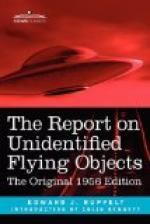Copies of these and other reports were going to the Pentagon, and I was constantly on the phone or having teleconferences with Major Fournet.
When the second Washington National Sighting came along, almost a week to the hour from the first one, by a stroke of luck things weren’t too fouled up. The method of reporting the sighting didn’t exactly follow the official reporting procedures that are set forth in Air Force Letter 200-5, dated 5 April 1952, Subject: Reporting of Unidentified Flying Objects—but it worked.
I first heard about the sighting about ten o’clock in the evening when I received a telephone call from Bob Ginna, Life magazine’s UFO expert. He had gotten the word from Life’s Washington News Bureau and wanted a statement about what the Air Force planned to do. I decided that instead of giving a mysterious “no comment” I would tell the truth: “I have no idea what the Air Force is doing; in all probability it’s doing nothing.” When he hung up, I called the intelligence duty officer in the Pentagon and I was correct, intelligence hadn’t heard about the sighting. I asked the duty officer to call Major Fournet and ask him if he would go out to the airport, which was only two or three miles from his home. When he got the call from the duty officer Major Fournet called Lieutenant Holcomb; they drove to the ARTC radar room at National Airport and found Al Chop already there. So at this performance the UFO’s had an official audience; Al Chop, Major Dewey Fournet, and Lieutenant Holcomb, a Navy electronics specialist assigned to the Air Force Directorate of Intelligence, all saw the radar targets and heard the radio conversations as jets tried to intercept the UFO’s.
Being in Dayton, 380 miles away, there wasn’t much that I could do, but I did call Captain Roy James thinking possibly he might want to talk on the phone to the people who were watching the UFO’s on the radarscopes. But Captain James has a powerful dislike for UFO’s— especially on Saturday night.
About five o’clock Sunday morning Major Fournet called and told me the story of the second sighting at Washington National Airport:
About 10:30P.M. on July 26 the same radar operators who had seen the UFO’s the week before picked up several of the same slow-moving targets. This time the mysterious craft, if that is what they were, were spread out in an arc around Washington from Herndon, Virginia, to Andrews AFB. This time there was no hesitation in following the targets. The minute they appeared on the big 24-inch radarscope one of the controllers placed a plastic marker representing an unidentified target near each blip on the scope. When all the targets had been carefully marked, one of the controllers called the tower and the radar station at Andrews AFB—they also had the unknown targets.
By 11:30P.M. four or five of the targets were continually being tracked at all times, so once again a call went out for jet interceptors. Once again there was some delay, but by midnight two F-94’s from New Castle County AFB were airborne and headed south. The reporters and photographers were asked to leave the radar room on the pretext that classified radio frequencies and procedures were being used in vectoring the interceptors. All civilian air traffic was cleared out of the area and the jets moved in.




